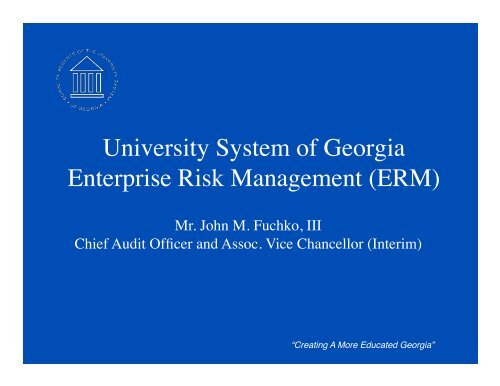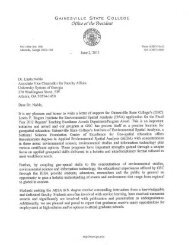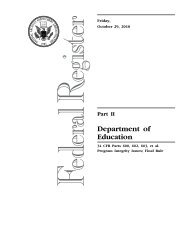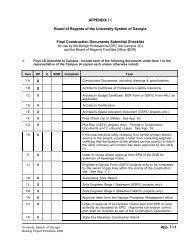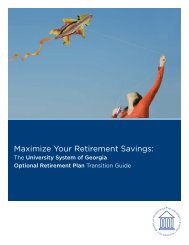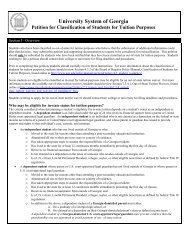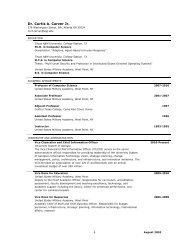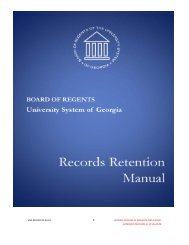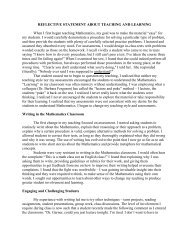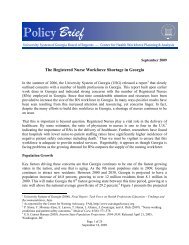ERM Presentation.pdf - University System of Georgia
ERM Presentation.pdf - University System of Georgia
ERM Presentation.pdf - University System of Georgia
Create successful ePaper yourself
Turn your PDF publications into a flip-book with our unique Google optimized e-Paper software.
<strong>University</strong> <strong>System</strong> <strong>of</strong> <strong>Georgia</strong>Enterprise Risk Management (<strong>ERM</strong>)Mr. John M. Fuchko, IIIChief Audit Officer and Assoc. Vice Chancellor (Interim)“Creating A More Educated <strong>Georgia</strong>”
Agenda• What is <strong>ERM</strong>?• How are we implementing <strong>ERM</strong>?• The Way Ahead2“Creating A More Educated <strong>Georgia</strong>”
What is <strong>ERM</strong>? (1/5)<strong>ERM</strong> is a process-driven tool that enablessenior management to visualize, assess, andmanage significant risks that may adverselyimpact the attainment <strong>of</strong> key organizationalobjectives. – USG Definition3“Creating A More Educated <strong>Georgia</strong>”
What is <strong>ERM</strong>? (2/5)• <strong>ERM</strong> is:– A logical, disciplined approach to “seeing” andcategorizing risk– Time intensive at launch– A tool to positively change culture– Focused on accountability4“Creating A More Educated <strong>Georgia</strong>”
What is <strong>ERM</strong>? (3/5)• <strong>ERM</strong> is not:– Solely a function <strong>of</strong> business affairs ortraditional risk management functions– Bureaucratic– Independent from strategic planning; rather, itis core to achieving strategic objectives5“Creating A More Educated <strong>Georgia</strong>”
What is <strong>ERM</strong>? (4/5)• Risks are categorized as follows:– Strategic– Compliance– Reputational– Financial– Operational6“Creating A More Educated <strong>Georgia</strong>”
What is <strong>ERM</strong>? (5/5)7“Creating A More Educated <strong>Georgia</strong>”
How does <strong>ERM</strong> “work?” (1/4)Step 1 – Establish <strong>ERM</strong>FrameworkA. Identify Project Champion – Executive-level <strong>of</strong>ficial (Chancellor,President, Chief X Officer) who will provide support and directionto process.B. Identify Project Owner - Senior-level <strong>of</strong>ficial who will provideongoing management and oversight to <strong>ERM</strong> implementation.C. Establish Steering Committee – Executive/senior-level <strong>of</strong>ficialsrepresenting key organizational areas.• Working Groups will be established on an ad hoc basis to brainstormand assess key risks.“Creating A More Educated <strong>Georgia</strong>”8
How does <strong>ERM</strong> “work?” (2/4)Step 2 – Identify Key Obj.A. List key objectives – Steering Committee identifies institutionaland USG strategic objectives.B. Prioritize objectives – Steering Committee uses ranking or othersystem to select top objectives (should not exceed 3-5 objectivesper division head).C. Select objectives for assessment – Steering Committee selects4-6 top objectives for initial risk assessment by the SteeringCommittee. (Note: Steering Committee will select next 4-6 topobjectives for risk assessment on an ongoing basis until all keyobjectives have undergone risk assessment.)“Creating A More Educated <strong>Georgia</strong>”
How does <strong>ERM</strong> “work?” (3/4)Step 3 – Identify Key RisksA. Brainstorm and assess risks – Steering Committee conducts initial riskassessment through calculation <strong>of</strong> impact and likelihood withoutconsideration <strong>of</strong> current controls or mitigation plans.1. Steering Committee must understand the key components/processassociated with selected objectives.2. Objectives may be assigned to a Project Owner/Responsible Individual foranalysis and presentation to the Steering Committee to assist with the riskdevelopment process.B. Assign risks rated 4 or higher to a specific Risk Owner.“Creating A More Educated <strong>Georgia</strong>”
How does <strong>ERM</strong> “work?” (4/4)Step 4 – Manage RisksA. Identify current controls and mitigation requirements – Risk ownersidentify the current controls, mitigation steps, or other actions alreadytaken by the institution to reduce risk. The risk is assessed again todetermine likelihood and impact.B. Develop mitigation plan for key risks – Risk owners develop mitigationplans for risks still ranked 4 or higher.C. Conduct quarterly meetings to review status – Steering Committee holdsquarterly meetings to approve and to review the status <strong>of</strong> risk ownermitigation plans. Risk scores may be adjusted by the SteeringCommittee to reflect the risk after implementation <strong>of</strong> the mitigation plan.D. Continue process – Steering Committee incorporates new risks into the<strong>ERM</strong> process (steps 2-4) as current risks are mitigated“Creating A More Educated <strong>Georgia</strong>”
Saving the Best for Last• Key Points to Remember– Risk, in one form or another, is present in virtually allworthwhile endeavors.– <strong>ERM</strong> is a management tool – this process can andshould be changed to work for YOUR organization.– <strong>ERM</strong> ultimately should change the organizationalculture – however, change is slow, painful, and timeconsuming.Frustration and confusion are simply part<strong>of</strong> the process – the long-term result is worth it.“Creating A More Educated <strong>Georgia</strong>”
The Way Ahead13USO will support <strong>ERM</strong> implementation by:• Supporting additionalpilots:– <strong>University</strong> <strong>System</strong>Office– Research institution• Refining <strong>ERM</strong> model:– Collaborative effort– Scalable– Risk visibility• Identifying solutions– Facilitate sharing <strong>of</strong><strong>ERM</strong> risks andmanagement solutionsamong institutions– Identify and manage“system” risks“Creating A More Educated <strong>Georgia</strong>”
Questions?14“Creating A More Educated <strong>Georgia</strong>”


